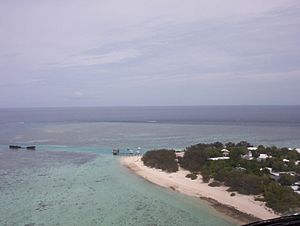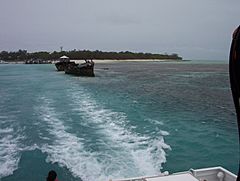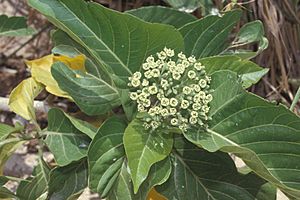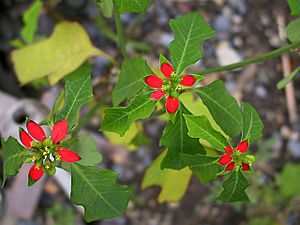Heron Island (Queensland) facts for kids
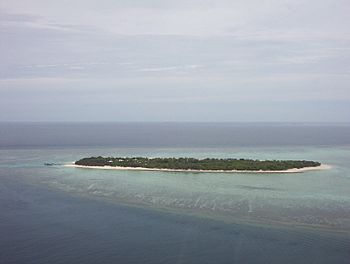
Heron Island from helicopter, looking north-northeast.
|
|
| Lua error in Module:Location_map at line 420: attempt to index field 'wikibase' (a nil value). | |
| Geography | |
|---|---|
| Location | In the southern Great Barrier Reef |
| Area | 0.29 km2 (0.11 sq mi) |
| Length | 0.8 km (0.5 mi) |
| Width | 0.3 km (0.19 mi) |
| Highest elevation | 3.6 m (11.8 ft) |
| Administration | |
|
Australia
|
|
| State | Queensland |
Heron Island is a small, beautiful coral island located in the southern part of the amazing Great Barrier Reef. It's about 80 kilometers (50 miles) northeast of Gladstone, Australia.
Heron Island sits on the western side of Heron Reef. This reef is full of life! It has about 900 different kinds of fish and 72% of all the coral types found in the Great Barrier Reef. In summer, over 200,000 birds, like Noddy Terns and Mutton Birds, call the island home.
The island is about 800 meters (2,600 feet) long and 300 meters (980 feet) wide. Its highest point is only 3.6 meters (12 feet) above sea level.
Heron Island is even mentioned in a science fiction book! It's part of the setting for the first half of Arthur C. Clarke's book, The Deep Range.
Contents
Island History: Discovering Heron Island
There is no sign that Australia's First Peoples ever lived on Heron Island. This is because it is quite far, over 65 kilometers (35 nautical miles), from the mainland.
A Royal Navy expedition found the island on January 12, 1843. This group was exploring the eastern edge of the Great Barrier Reef. Their goal was to create detailed maps for safe passages through the reef. Lieutenant Charles Bampfield Yule, who commanded one of the ships, named the island.
The island didn't have people living on it until the early 1900s. At that time, a factory was built to can green turtles. The idea was to make money from the many turtles that visited the island. However, this business soon struggled and closed. Other attempts to start fishing businesses also failed.
In 1932, Captain Christian Poulsen saw the island's potential for tourism. He used to bring fishing groups to the reef. In 1936, he bought the right to use the island for £290. Later, on September 11, 1943, the entire island was made a National Park. This means it is a protected area.
What Heron Island is Used For
Heron Island Resort: A Place to Visit
The Heron Island Resort is located on the northwest side of the island. It's a popular spot for scuba diving and snorkelling. The resort can host up to 300 guests and has 100 staff members. In 2012, the resort was even shown in the BBC nature TV series, Great Barrier Reef.
Heron Island Research Station: Studying the Reef
The University of Queensland Heron Island Research Station is on the southwest part of the island. It was started in the 1950s. This facility is one of the most important places in the world for studying coral reefs. Scientists here do a lot of research on how coral reefs work.
Sadly, the research station had a big fire on March 30, 2007, but no one was hurt. New student housing and research buildings were opened in 2008 and 2009. In 2010, a special facility for climate change experiments was also opened. Famous naturalist Sir David Attenborough filmed parts of his documentary, David Attenborough's Great Barrier Reef, here in 2014.
National Park: Protecting Nature
The eastern half of Heron Island is a protected area. It is part of the Capricornia Cays National Park. There is a park ranger station on the island to help look after the park.
Harbour: Island Gateway
There is a small, man-made channel and a wooden jetty on the western shore. This is where the daily catamaran boat from Gladstone docks. Supplies for the island are also delivered here. The old, rusted wreck of HMCS Protector lies at the entrance to the channel. It was placed there in 1945 to help protect boats from waves.
Utilities: How the Island Works
Heron Island does not have its own fresh water supply. A special plant on the island uses a process called reverse osmosis to turn seawater into drinking water. Also, three diesel generators and some solar panels provide electricity for the island.
Heron Island's Amazing Ecology
Heron Island has very rich soil for a coral island. This is because tens of thousands of wedge-tailed shearwaters (a type of bird) live here during breeding season. These birds dig their nests, which helps mix the soil and keep it healthy.
Flora: The Plants of Heron Island
Tall Pisonia grandis trees cover the center and south of Heron Island. In some areas, the forest is easy to walk through. However, its middle is a very dense tangle of trees and plants.
Some trees in the forest can grow up to 10–11 meters (33–36 feet) tall. Most are about 6–8 meters (20–26 feet) high. There are not many smaller plants growing under these trees. You might see a few Celtis paniculata, Ficus opposita, and Pipturus argenteus plants. Patches of shrubs, like Abutilon albescens and Melanthera biflora, are also found. The introduced wild poinsettia (Euphorbia cyathophora) also grows here.
North of the Pisonia forest, there is an open area with shrubs and some trees. Octopus bush (Heliotropium foertherianum) and sea cabbage (Scaevola taccada) are common here. You can also find Pandanus tectorius trees and she-oak trees.
The eastern part of the island has similar plants. On the sand dunes, you can find plants like Boerhavia repens, Cakile edentula (searocket), and different types of Euphorbia.
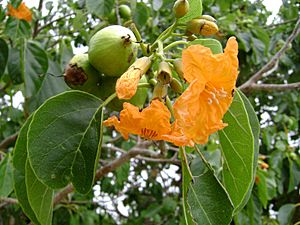
Near the resort, in the northwest, there is another type of forest. The main tree here is the manjack Cordia subcordata.
The sea turtle nesting area is on the northern shore. Because turtles dig their nests, a thick forest cannot grow here. Instead, the sand is covered with smaller plants and shrubs.
Around the western end of the island, you can find many plants that were brought by people. Some were planted on purpose as decorative plants, like papaya and coconut palm. Others arrived by accident.
Fauna: The Animals of Heron Island and Their Life Cycle
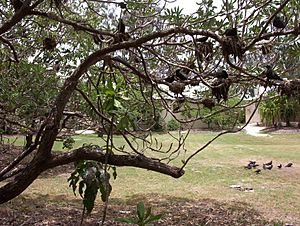
Heron Island is an Important Bird Area. This means it's a very important place for birds. Thousands of seabirds nest here, including the wedge-tailed shearwater and the black noddy. They breed between October and April. Over 120,000 white-capped noddies nest on the island during this time.
Birds that live and breed on Heron Island all year include:
- Silver gull
- Eastern reef egret
- Buff-banded rail
- Bar-shouldered dove
- Sacred kingfisher
- Black-faced cuckooshrike
- Capricorn silvereye
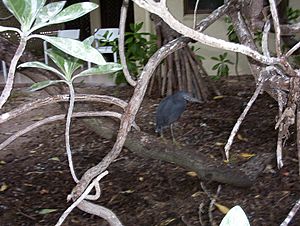
The eastern reef egret is the main type of "heron" that lives and breeds on the island. This bird is actually an "egret," which is a smaller type of heron. The island is named after these birds.
Since 2003, a pair of white-bellied sea eagles have nested on Heron Island. Sadly, in 2019, the tree with their nest fell, and the female eagle died. The male eagle has since been seen with another adult.

A type of rat, probably the polynesian rat, lives on the island. While these rats might eat some bird eggs, they do not threaten the overall bird populations.
Heron Island is a very important nesting site for green and loggerhead sea turtles. About 98% of all turtles that nest here are green turtles. The Indopacific hawksbill sea turtle has been seen on the reef but does not nest on the island. Other marine life includes many creatures that live in the coral reef. In early October, large cetaceans, like humpback whales, pass by Heron Island on their way to colder waters.
As of June 2020, scientists are working on "The Turtle Cooling Project." This project looks at how global warming affects green turtle breeding. Higher temperatures can cause more male turtles to be born. Scientists are studying this in the area around Heron Island.
A small marine snail called Cerithium moniliferum is also found on Heron Island. These snails form large groups when the tide goes out. They feed on rocks and move slowly in their groups. This helps them stay moist and breathe when out of the water.
Mosquitoes and other biting insects are rare on the island. However, some diseases carried by mosquitoes have been found in the island's silvereyes (a type of bird).
Heron Island's Geology
Heron Reef is a type of reef called a lagoonal platform reef. This means it has a flat top with a shallow pool (lagoon) in the middle. It formed in an area with strong ocean currents, which helps keep the water clean and clear. The reef is quite old, dating back to the Holocene period. Studies of the reef show it is at least 15 meters (49 feet) thick.
Society and Culture on Heron Island
Known Shipwrecks on the Reef
The Jane Lockhart was a two-mast schooner ship that sank between December 11 and 17, 1868. It was carrying general cargo from Sydney. The ship ran aground near Heron Island. The crew safely reached another island.
When a rescue boat found the Jane Lockhart, it was stuck in a hollow part of the reef. The outside of the hollow acted like a wall against the waves. The crew of the rescue boat removed the sails to keep the ship from moving more. Six months later, another ship visited the wreck. They found the Jane Lockhart still in a good spot. They managed to bring up many items, including iron wheels, machinery, and drinks.
Voyager Spacecraft: A Photo from Earth
A photo of Heron Island is included on the Voyager Golden Record. This special record was sent into space on the Voyager 1 and Voyager 2 spacecraft. These spacecraft are now traveling beyond our Solar System. The picture of Heron Island was chosen to show the amazing variety of life and culture on Earth.
See also
 In Spanish: Heron Island para niños
In Spanish: Heron Island para niños


